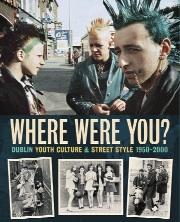Where were you? Dublin youth culture & street style 1950–2000
Published in 20th Century Social Perspectives, 20th-century / Contemporary History, Book Reviews, Issue 2(March/April 2012), Reviews, Volume 20
Where were you? Dublin youth culture & street style 1950–2000
Gary O’Neill
(Hi Tone Books, Ä29.99)
ISBN 9780956949301
Nostalgia is a powerful feeling. I was immediately transported back to my teenage years while leafing through Gary O’Neill’s book. Having been part of the early Punk scene in Dublin, memories come flooding back while looking through the section on the 1970s and ’80s. The book itself is a photographic record of those different youth cultures, with little commentary to distract. A labour of love for the author, his dedication can be judged by the fact that he had to trawl through c. 5,000 photos over ten years before he selected the final 800. All youth culture is captured here, mostly by the participants themselves—Teddy Boys, Mods, Rockers, Hippies, Skinheads, Boot Boys, Punks, Rude Boys and Goths. Even short-lived styles such as Suedeheads and Break-dancers get a mention. Interestingly, there are even a couple of photos of the infamous ‘Bugsy Malone’ gang from Summerhill, featuring a young man who would later appear on the front of the Sunday World as ‘the Monk’. Knowing little about the cult of the original Skinheads in Dublin in the ’60s, I found their pictures fascinating. Having remembered the Boot Boy style while growing up, the few photos of this youth culture also caught my attention. Naturally, my biggest interest was in the section encompassing the late 1970s and ’80s—page after page, spotting friends and enemies alike. Particularly poignant are the photos of friends no longer with us, such as Kevin Leonard, Harry Callaghan and Cindy Teeling Donnelly.I remember vividly buying the Sex Pistols’ God Save the Queen and excitedly playing it for my parents. Seeing their horror at my newfound musical taste, I tried to impress them by telling them that lead singer Johnny Rotten was Irish! Once bitten by the music bug I was smitten. The next decade and a half were spent immersing myself in the Punk culture, buying records and following the bands. Visits to London to buy records and see the bands were fairly regular occurrences. Memories of the bus trip from Dublin to London still haunt me. Hours spent on cramped buses with no toilets and very few ‘relief’ stops. Still, it didn’t stop us drinking! It wasn’t just the music that was exciting. It was the fact that you could wear homemade clothes such as torn T-shirts, stencilled jackets and ripped jeans and look so cool because you stood out from the crowd. It was going to gigs that ended after the last bus had left and having to walk home at sixteen years of age. It was making new friends from all over the city with a common taste in music and style. Even the threat of violence was exciting at that age. I’m sure the irony isn’t lost on those reading a 50-year-old man harking back to the days when the Belfast band Protex sang ‘I don’t want to be alive/when I’m 25’—and we really believed it! Even Dunnes Stores selling T-shirts with ‘punk’ written on them in the late ’70s couldn’t dampen our enthusiasm for our ‘alternative’ culture. A noticeable feature of the photos is that those chosen are mainly from working-class areas. The inner city features heavily, as do other working-class areas such as Ballyfermot, Cabra, Drimnagh, Finglas, Ringsend, etc. In the early years of the Punk scene there was an arty student core that looked down on the more working-class elements, but they moved on as the music became more popular and less élite.The initial Punk scene had little or no politics, despite the overtly political sloganeering of bands like the Clash and the Gang of Four. The Thatcher years definitely resulted in a politicisation of the Punk scene in Britain. The rise of the National Front also contributed. The huge Anti-Nazi League music festivals mainly featured Punk, New Wave or Reggae bands. The politicisation of the Punk scene in Britain, and in particular the politicisation of the bands, had a direct effect on the Irish Punk scene. Bands such as Crass and the Dead Kennedys were clearly anti-capitalist and anti-fascist. Any fascist Punk bands or supporters quickly submerged themselves in the growing neo-Nazi Skinhead, or Bonehead, scene in Britain. In Ireland in the ’80s there was a polarisation of the music scene, with Blood and Honour-influenced neo-Nazi skinheads attempting to dominate the streets. The author makes a vague reference to this: ‘The scene split and fragmented as a result of varying political beliefs’. A number of violent confrontations between left-wing Punks and neo-Nazi Skinheads had seen the fascists coming off a poor second best. There are a number of photos of Skinheads wearing neo-Nazi T-shirts, when in fact it wasn’t safe for fascists in Dublin to openly display Nazi paraphernalia. The risk of a beating by the ‘Reds’ was a constant threat that eventually resulted in the neo-Nazis retiring.This book will attract those with an interest in viewing a historical record of the different subcultures at large in Dublin at various times, but more particularly it will be snapped up by those who are recorded for posterity within its pages, serving as a reminder of the times when we were all a little less bald, a little less chubby and a lot more idealistic. HI
Cieran Perry is a Dublin City councillor.
















